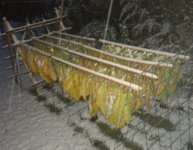Barley, Hordeum vulgare, is a spring planted cereal grain used mostly in animal fodder. You may have eaten it in the form of pearled barley in some kind of soup or casserole. Also, certain varieties of barley are used to make malt, which is the main ingredient in beer making.
Barley is harvested the same way as wheat with the same combine. The main limitation on the harvesting of barley would be the moisture content of the straw as well as the moisture content of the grain itself. The moisture content of the straw makes it difficult to cut the straw and thereby difficult to put the crop through the threshing mechanism. Fortunately, straw doesn't have a lot of substance, and a few days of dry weather will alleviate that problem. Excess moisture in the grain itself is a significant problem. First, moist grain is difficult / impossible to thresh properly, and second, to store the grain, the maximum moisture content must be lower than 12%. Anything higher than that will cause rot, which causes heat, which causes explosions in the grain bin. Hence the "dryers". A dryer is really just a big fan coupled (sometimes) with a heater that circulates dry air into the storage bin bringing down the moisture content of the stored grain. Usually, the heat of the day and the low humidity of the air is used for drying. I have heard of gas fired heaters being used, but that is generally cost prohibitive as barley isn't that valuable. The local price (here) yesterday was $130 per ton. Average yields around here in grain country is 1 to 1 1/2 (2 - 3,000#'s) tons per acre. A really good (exceptional) crop would be 3 tons (6,000 #'s) per acre. You are on your own on metric conversions. A hectare is 100 x 100 meters or 10,000 square meters or 2.47 acres.
The Canadian government via the bureaucratic grain board controls and manipulates the supply and thereby price of wheat in Canada. I don't know if the grain board has dominion over feed grains. If you are a wheat farmer in Canada, you have to wait three years to get paid for your crop. As far north as you are, the farmers probably can't grow wheat due to the harshness of the winters. Barley, being a spring planted crop, and a short season crop, will grow successfully in that northern climate. There are certain areas in the interior of Alaska (farther north than you are) where they grow barley to feed to cattle. Barley has been a staple crop in places like Scotland for a very long time. (animal feed, beer, whiskey).
Wes H.
Part time Farm Boy



